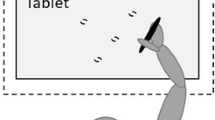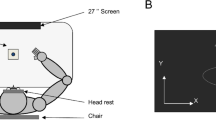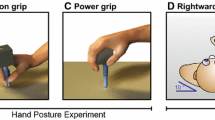Abstract
It has been shown that learning visuomotor rotations with multiple target directions, compared with a single target direction, leads to greater generalization to untrained targets within the same limb. This implies that multiple direction learning results in a more complete internal model of the visuomotor transform. It has also been documented that the extent of transfer of movement information regarding visuomotor adaptations between the limbs is limited, relative to that between different configurations of the same limb. The present study thus investigated the origin of this restriction in interlimb transfer, by comparing the effects of eight-direction and one-direction training conditions with one arm on the subsequent performance with the other arm. It was hypothesized that if multiple direction learning leads to a more complete model of the novel visuomotor transform, interlimb transfer should be enhanced relative to that following single direction training. However, if no differences are observed between single and multiple direction training conditions, this would suggest that such learning is effector dependent. We also tested the hypothesis that interlimb transfer of visuomotor adaptation is not obligatory, by examining the effects of visual rotation direction (same or oppositely directed visuomotor rotations for the two arms). All subjects first adapted to a 30° rotation, either clockwise or counterclockwise, in the visual display during reaching movements. Following this, they adapted to a 30° rotation in either the same or opposing direction with the other arm. Results showed that initial training with the non-dominant arm facilitated subsequent performance with the dominant arm in terms of initial direction control, but only under the same rotation condition. Both single and eight direction training conditions led to substantial transfer in subsequent performance with the other arm, but multiple direction training was no more beneficial than single direction training. This finding suggests that the previously reported intralimb advantages of multiple direction learning are effector specific. Our findings are discussed in the context of hierarchical models of motor control to explain the intralimb advantages of multiple direction training.




Similar content being viewed by others
References
Criscimagna-Hemminger SE, Donchin O, Gazzaniga MS, Shadmehr R (2003) Learned dynamics of reaching movements generalize from dominant to nondominant arm. J Neurophysiol 89:168–176
Dizio P, Lackner JR (1995) Motor adaptation to Coriolis force perturbations of reaching movements: endpoint but not trajectory adaptation transfers to the nonexposed arm. J Neurophysiol 74:1787–1792
Elliott D, Roy EA (1981) Interlimb transfer after adaptation to visual displacement: patterns predicted from the functional closeness of limb neural control centres. Perception 10:383–389
Ghahramani Z, Wolpert DM, Jordan MI (1996) Generalization to local remappings of the visuomotor coordinate transformation. J Neurosci 16:7085–7096
Ghez C, Hening W, Favilla M (1989) Gradual specification of response amplitude in human tracking performance. Brain Behav Evol 33:69–74
Ghez C, Hening W, Gordon J (1991) Organization of voluntary movement. Curr Opin Neurobiol 1:664–671
Imamizu H, Shimojo S (1995) The locus of visual-motor learning at the task or manipulator level: implications from intermanual transfer. J Exp Psychol Hum Percept Perform 21:719–733
Imamizu H, Uno Y, Kawato M (1998) Adaptive internal model of intrinsic kinematics involved in learning an aiming task. J Exp Psychol Hum Percept Perform 24:812–829
Jordan MI, Rumelhart DE (1992) Forward Models: supervised learning with a distal teacher. cognitive science 16:307–354
Kawato M (1999) Internal models for motor control and trajectory planning. Curr Opin Neurobiol 9:718–727
Kawato M, Isobe M, Maeda Y, Suzuki R (1988) Coordinates transformation and learning control for visually-guided voluntary movement with iteration: a Newton-like method in a function space. Biol Cybern 59:161–177
Kawato M, Maeda Y, Uno Y, Suzuki R (1990) Trajectory formation of arm movement by cascade neural network model based on minimum torque-change criterion. Biol Cybern 62:275–288
Krakauer JW, Ghilardi MF, Ghez C (1999) Independent learning of internal models for kinematic and dynamic control of reaching. Nat Neurosci 2:1026–1031
Krakauer JW, Pine ZM, Ghilardi MF, Ghez C (2000) Learning of visuomotor transformations for vectorial planning of reaching trajectories. J Neurosci 20:8916–8924
Laszlo JI, Baguley RA, Bairstow PJ (1970) Bilateral transfer in tapping skill in the absence of peripheral information. J Mot Behav 2:261–271
Logan GD (1988) Toward an instance theory of automatization. Psychol Rev 95:492–527
Marzi CA, Bisiacchi P, Nicoletti R (1991) Is interhemispheric transfer of visuomotor information asymmetric? Evidence from a meta-analysis. Neuropsychologia 29:1163–1177
Morton SM, Lang CE, Bastian AJ (2001) Inter- and intra-limb generalization of adaptation during catching. Exp Brain Res 141:438–445
Oldfield RC (1971) The assessment and analysis of handedness: the Edinburgh Inventory. Neuropsychologia 9:97–113
Parlow SE, Kinsbourne M (1989) Asymmetrical transfer of training between hands: implications for interhemispheric communication in normal brain. Brain Cogn 11:98–113
Rosenbaum DA, Chaiken SR (2001) Frames of reference in perceptual-motor learning: evidence from a blind manual aiming task. Psychol Res 65:119–127
Sainburg RL (2002) Evidence for a dynamic-dominance hypothesis of handedness. Exp Brain Res 142:241–258
Sainburg RL, Wang J (2002) Interlimb transfer of visuomotor rotations: Independence of direction and final position information. Exp Brain Res 145:437–447
Stoddard J, Vaid J (1996) Asymmetries in intermanual transfer of maze learning in right- and left-handed adults. Neuropsychologia 34:605–608
Taylor HG, Heilman KM (1980) Left-hemisphere motor dominance in righthanders. Cortex 16:587–603
Thut G, Cook ND, Regard M, Leenders KL, Halsband U, Landis T (1996) Intermanual transfer of proximal and distal motor engrams in humans. Expl Brain Res 108:321–327
Tong C, Wolpert DM, Flanagan JR (2002) Kinematics and dynamics are not represented independently in motor working memory: evidence from an interference study. J Neurosci 22:1108–1113
Vetter P, Goodbody SJ, Wolpert DM (1999) Evidence for an eye-centered spherical representation of the visuomotor map. J Neurophysiol 81:935–939
Wang J, Sainburg RL (2003) Mechanisms underlying interlimb transfer of visuomotor rotations. Exp Brain Res 149:520–526
Wigmore V, Tong C, Flanagan JR (2002) Visuomotor rotations of varying size and direction compete for a single internal model in motor working memory. J Exp Psychol Hum Percept Perform 28:447–457
Wolpert D, Ghahramani Z (2000) Computational principles of movement neuroscience. Nat Neurosci 3:1212–1217
Acknowledgements
This research was supported by US National Institutes of Health grants R01HD39311 and NRSA 1-F32-NS-46239-1.
Author information
Authors and Affiliations
Corresponding author
Rights and permissions
About this article
Cite this article
Wang, J., Sainburg, R.L. Limitations in interlimb transfer of visuomotor rotations. Exp Brain Res 155, 1–8 (2004). https://doi.org/10.1007/s00221-003-1691-2
Received:
Accepted:
Published:
Issue Date:
DOI: https://doi.org/10.1007/s00221-003-1691-2




